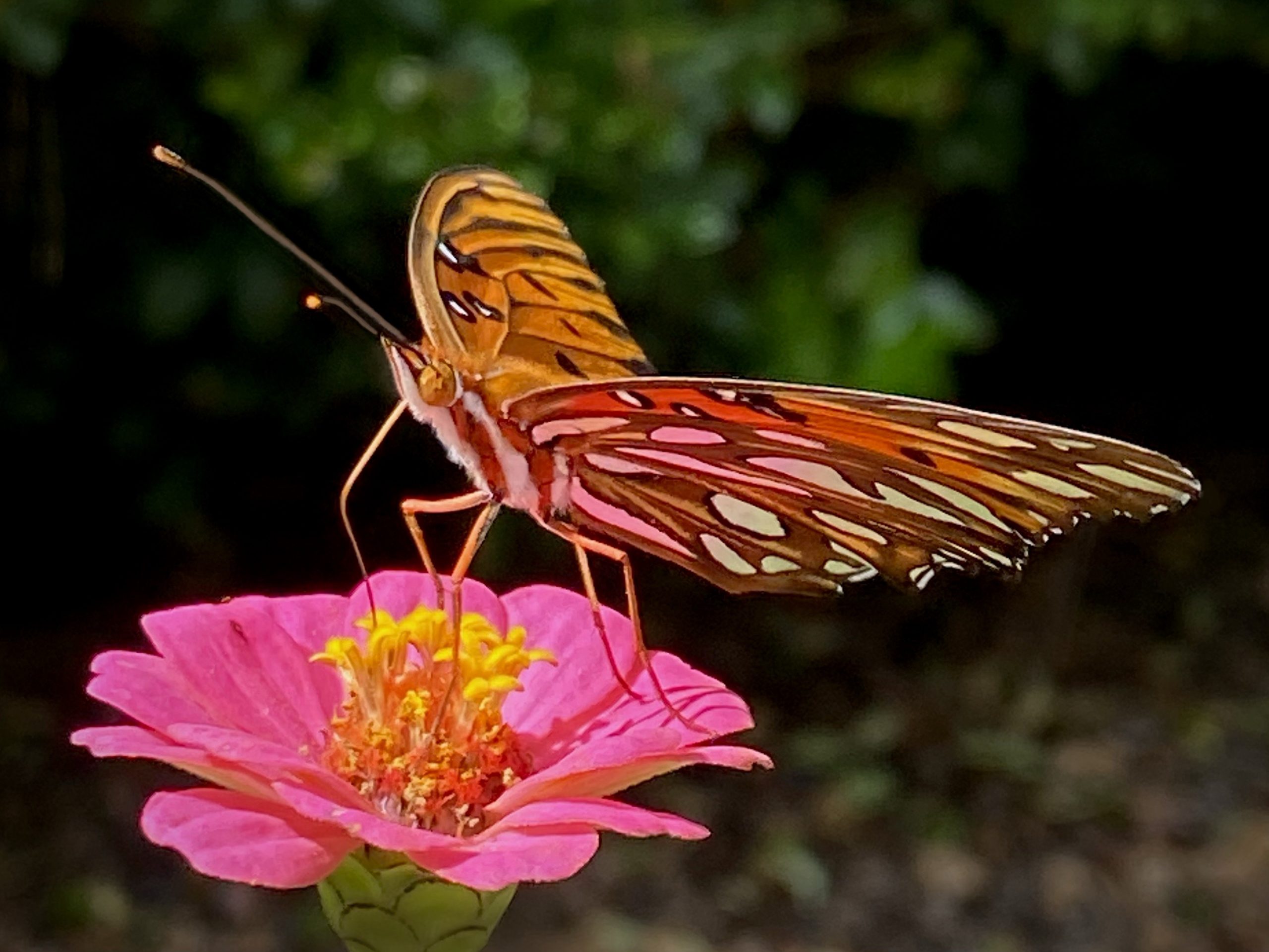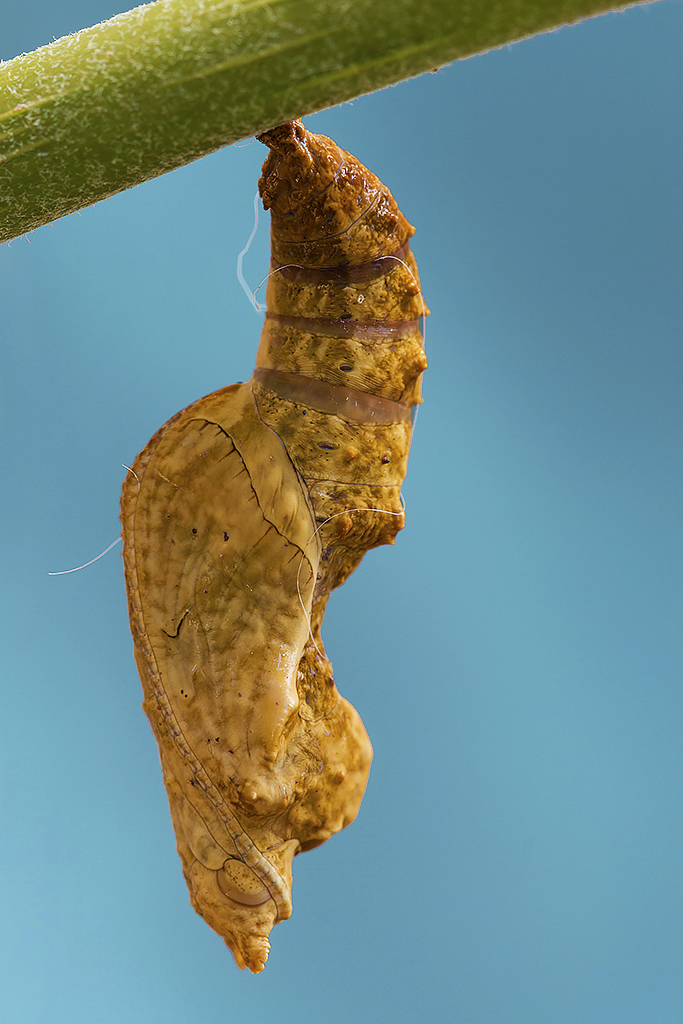
Like the proverbial ugly duckling, the spiky caterpillar undergoes an incredible transformation in its chrysalis to become the stunning Gulf fritillary butterfly! I learned how to move around it, capturing close-up images without scaring it away. This gave me the opportunity to look at the butterfly’s eyes in a way that was more like looking at another person.
On a hot South Carolina day while working with Jim Hightower in his Columbia garden, a dancing butterfly caught my eye as it moved among zinnias. Out came my camera, followed by several minutes of pure joy in which I became unaware of anything other than that butterfly and my camera. The small creature, a Gulf fritillary, moved from flower to flower as if posing to make possible one great shot after another. While generally very focused on my work as a professional gardener and garden consultant, I do not hesitate to pause for a moment when a great photo op presents itself.
Previously partial to bees, I grew to love this delicate creature. I learned how to move around it, capturing close-up images without scaring the butterfly away. This made it possible to pay attention to background and composition. It also gave me the opportunity to look at the butterfly’s eyes in a way that was more like looking at another person. Adjusting the scale of small creatures by observing through a zoom lens has completely changed the way I relate to them.
The garden of Jim and Marjie, his wife, is filled with beautiful plants. One plant in their garden that I have often admired is called Passiflora incarnata, or passionflower vine. This vine produces an intricate flower, often referred to as a maypop, that first caught my eye when my sister and I were exploring the bank of the Cumberland River — a river that flowed directly behind our childhood home in Nashville. I remember digging up a vine from the bank across the river and trying, unsuccessfully, to transplant the vine into our backyard.

After working in Jim and Marjie’s garden, however, I purchased seeds and planted them in an old nursery pot. Now on a mission to grow my own passion vine, I was eager to observe green poking up through the soil. For days, I kept a close watch on the pot. Nothing. The seeds were very slow to sprout and when they did, they grew about 3 inches and then stopped.
Months later I was looking down at the pot, forced to consider the fate of both pot and plants — a consideration I was making with all of my possessions. I was in the process of moving from my home of many years. At a time when simply putting one foot in front of the other had become work and being finished was what I most wanted, the plants in that pot stared up at me. I could almost hear them. “We have emerged and grown to an impressive 3 inches in height and you are going to ditch us now?”
“Yes, I am,” I thought. “Yes. I am!” But action did not match thought. I bent down and picked up the pot. It made the move and was placed with little concern in new surroundings.
Slowly, those little vines began to take off. They were growing, reaching up for support, spreading out in all directions. I slipped the plants out of the pot and eased them into the earth. Adding an old trellis, I smiled, looking forward to beautiful blooms. The stunted 3-inch vines had come to life and were now growing as if they were in a race. This robust growth continued for weeks.

And then, one day, horror of horrors — I happened to glance in the direction of my vines. Stems. Just stems. Where were the leaves? Shocked and angered, from a distance I spoke loudly to the vines. “Who has done this most awful thing to you?” There was no reply from the denuded and pitiful vines hanging on the trellis. I stood frozen, staring at the destruction. Then something caught my eye — movement.
As I drew closer, it became evident that the culprits were still there. My face crinkled up tightly as if sensing a bad taste in my mouth. My head turned slowly from side to side, the way a parent might send their child a silent message. No, no, no. Those rotten creatures that had decimated my vines were still there, boldly finishing the last of the leaves. After directing a loud string of choice words at the creatures, then out came my camera. I photographed caterpillars holding on to vines, caterpillars holding on to leaves, caterpillars chewing leaves, two in one shot, three in another. I counted and observed a large variation in size. What was the name of this creature wrecking my passion vine?
A quick image search lead me straight to the unexpected answer — it was none other than my beloved Gulf fritillary. Stunned and shocked by the puzzle that was piecing itself together in my mind, I closed my eyes and paused. No way were these ravenous creatures covered with long dark spikes going to turn into my favorite butterfly. But they were.
Still standing next to what had recently been thriving vines, I looked back at those caterpillars, finishing the last of the leaves on what I had just learned was their host plant. They were out of food. These creatures needed more leaves.
At that moment an unexpected thought flashed through my mind. My iPhone still in hand, I closed search mode, shifted through a few screens and pressed call. “Jim,” I said urgently, doing my best to explain the situation. “Jim, I need to come to your house right away. I need leaves.” I do not know what Jim was thinking as he heard those words, but without pause, he agreed to my request. Within minutes I was in my car and on the way.

Jim and Marjie met me in the driveway. Marjie added water to a large pail, and together the three of us began pruning long leaf-covered vines and filling the pail. Once the pail was full, I thanked them, hurried home, and placed it at the base of my naked plants. Within minutes the caterpillars were crawling on the fresh supply of leaves that they continued to consume for several days.
The Gulf fritillary opened my eyes to connections. I love seeing a passion vine bloom, but now I skip the choice words when those wild looking caterpillars chew the leaves of this native vine. I make an effort to recommend and purchase native plants that are host plants for native creatures, plants that feed native caterpillars, plants that sustain the lives of bees and butterflies.
Jim and I have spotted and documented almost every part of the Gulf fritillary’s life cycle. This past fall, Jim was excited to show me a photograph of a chrysalis, the pupa from which the butterfly emerges, which he spotted at the Carolina Children’s Garden, where he volunteers as a master gardener. We delight in sharing our lucky shots — a female laying eggs, a pair of butterflies mating. A shared journey of discovery, revelation, and understanding of the connection between the Gulf fritillary and the passion vine has made observing the dance of this regular garden visitor a special sight indeed.










